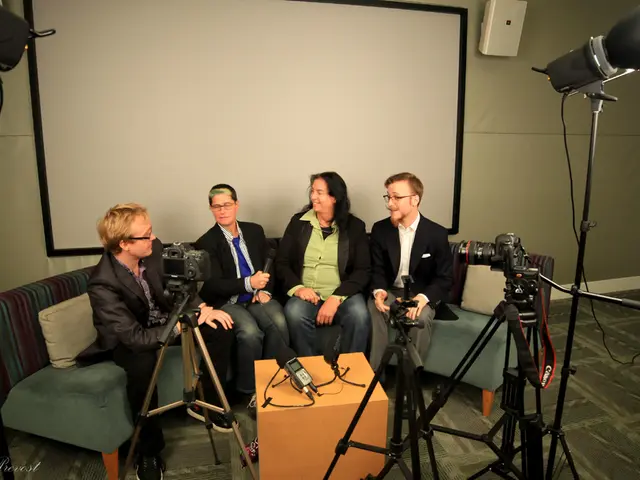Title: Navigating the Nigerian Education Landscape: Make Informed Decisions for a Bright Future
Navigating Education Choices for Nigerian Parents: An Overview of Available Learning Paths for Their Children
Welcome to our guide on finding the perfect education path for your child in Nigeria. In this rapidly evolving educational landscape, you have diverse options to mull over: traditional schools, Montessori systems, online learning platforms, and more. Navigating this vast ocean can seem tricky, but we're here to help you make informed decisions, ensuring a bright future for your child.
Why Your Choices Matter
Choosing the right educational path shapes a child's future. This decision impacts academic success, personal development, career prospects, and overall life journey. Parents play a pivotal role in guiding their children through this process, and their choices can significantly affect their child's educational journey.
The Rapidly Changing Education Scenario
Today's education landscape in Nigeria is witnessing a revolution, with anything conventional and ordinary becoming passé. As a parent, you must remain aware of these shifts, enabling you to make choices that cater to your child's unique needs.
Traditional Education vs Alternative Options
Understanding the Nigerian Education System
The National Policy on Education in Nigeria outlines the framework for various educational levels. The policy prioritizes accessibility, quality, and affordability for all Nigerian children. This policy emphasizes fundamental education, equating to a basic education for every child.
Nigeria's education system comprises three main tiers: primary, secondary, and tertiary education. Each tier has specific objectives and outcomes, creating a stepping stone towards a child's future.
Public Schools
Public schools offer a primary educational option for many families, following a standardized national curriculum, providing opportunities for social integration, and being tuition-free. Some disadvantages include limited resources, affecting the quality of education, and potential overcrowding in urban areas.
Private Schools
Besides public schools, private schools have gained popularity owing to smaller class sizes, better facilities, and engaged parental involvement. They come in various formats, such as Montessori schools or British-based curriculum schools, catering to diverse learning styles and aspirations. However, the downside is significant tuition costs, which may seem unaffordable for some families.
International Schools
International schools are an increasingly popular educational choice for those seeking a global curriculum, high educational standards, and exposure to diverse perspectives and practices. This can yield rewards like networking opportunities and job prospects in international arenas. However, their high tuition costs may deter some families.
Homeschooling
Homeschooling, while a less common option, provides a flexible and personalized learning environment for children. This method allows you to tailor the educational pace to your child's needs, foster family bonding, and integrate real-world experiences into the learning process. The disadvantages include time and parental commitment and a potential lack of socialization with peers.
Vocational and Technical Education
Vocational and technical education offers practical skill development, equipping students with hands-on experience in fields like plumbing, healthcare, and information technology. These programs provide students with immediate employment opportunities in high-demand jobs, encouraging self-sufficiency among youth.
Overcoming the Challenges in the Public Education System
While the Nigerian education system is progressive, Several challenges affect its effectiveness. Identifying and addressing these issues can pave the way for improvements. Some common challenges include:
- Infrastructure issues
- Teacher shortages and qualifications
- Quality of education
- Access and disparities
- Government policies and funding
- Cultural influences and attitudes
Exploring Alternative Education Pathways
Apart from the traditional routes, multiple alternative education options can cater to various learning preferences, interests, and aspirations.
- Skill Acquisition Programs and Internships: Skill development courses bridge the gap between education and employment, providing students with relevant skills necessary for career success. Internships offer practical, real-world experiences, boosting confidence.
- Online Learning Platforms: Online education expanded significantly during the COVID-19 pandemic, offering diverse educational resources from home. Platforms like Udemy, Coursera, edX, Khan Academy, and LinkedIn Learning offer courses taught by industry experts and flexible learning schedules. These platforms foster self-directed learning, helping students apply classroom knowledge in practical situations.
Factors to Consider When Choosing an Education Path
To ensure you make the right choice for your child, weigh these critical factors:
- Child's Learning Style and Interests
- Family Finances and Location Considerations
- Cultural Values and Community Expectations
- Academic Quality and Extracurricular Opportunities
Navigating the Admission Process
Navigating the admission process can seem daunting, but the steps remain essential:
- Research Potential Schools
- Check Admission Requirements
- Prepare Necessary Documents
- Submit Applications
- Prepare for Interviews/Entrance Exams
- Follow Up on Applications
Supporting Your Child's Educational Journey
Remember, as a parent, you play a crucial role in fostering a positive and supportive learning environment. Some tips to help you along the way include:
- Encouraging a Love for Learning at Home
- Communication with Educators and Involvement in School Activities
- Strategies for Managing Academic Stress and Promoting Mental Well-Being
Conclusion
Informed decision-making in your child's education is a game-changer. Balance quality and stability in the options, align with your child's abilities, interests, and career goals, and ensure financial feasibility. Be aware of educational policies and supportive structures to optimize your child's success journey.
Embarking on this quest requires dedication, patience, and active involvement. Let the right choices guide your child towards a successful future!
- Choosing the right educational path is crucial for shaping a child's future, as it impacts academic success, personal development, career prospects, and overall life journey.
- In the rapidly evolving Nigerian education landscape, parents must remain aware of shifts to make informed choices catering to their child's unique needs.
- Parents play a pivotal role in guiding their children through the educational process, and their choices can significantly affect their child's educational journey.
- The National Policy on Education in Nigeria outlines quality, accessibility, and affordability as its main objectives for all Nigerian children.
- Nigeria's education system consists of three main tiers: primary, secondary, and tertiary education, each with specific objectives and outcomes.
- Public schools provide opportunities for social integration and are tuition-free but may have limitations in resources, affecting the quality of education.
- Private schools offer better facilities and engaged parental involvement but have significant tuition costs, which may be unaffordable for some families.
- International schools are renowned for their global curriculum, high educational standards, and exposure to diverse perspectives, but their high tuition costs may deter some families.
- Homeschooling offers a flexible, personalized learning environment, fostering family bonding, integrating real-world experiences into learning, but may lack socialization with peers, require parental time commitment, and offer potential challenges.








